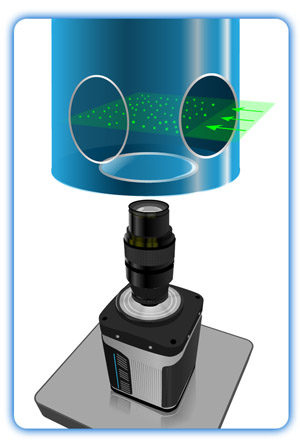Introduction

Our group has recently developed a technique to use solid hydrogen particles to visualize the flow in superfluid helium. The ability for bosons to condense into the ground state of a system at low temperatures can cause phase transitions which produce phenomena such as superconductivity, Bose-Einstein condensation, and superfluidity. Similar to other phase transitions, phase defects occur in these otherwise ordered states and have a dramatic impact on these systems. Magnetic line defects occur in type II superconductors. In the case of superfluidity, quantized vortices of the superflow form along filaments (line defects). We seek to understand the dynamics of these vortex defects and their impact on the phase transition.
Technique

Our visualization technique begins with the injection of hydrogen gas into the liquid helium above the superfluid transition temperature. The hydrogen forms solid particles of sizes of order 1 micron. Evaporative cooling is used to lower the temperature of the liquid helium below the superfluid transition. The solid hydrogen is attracted to and trapped by the filaments of the vortices and may then be used to directly visualize the formation and dynamics of the line vortices in the bulk of the superfluid.
This work was published in Nature 1 June 2006 and is available here.
Images taken from our experiments are shown below. The first pair shows the phase transition, with liquid-phase helium on the left and superfluid helium on the right.

Dissertations
- David P. Meichle, Characterization of Quantum Vortex Dynamics in Superfluid Helium, UMD 2015
- Gregory P. Bewley, Using frozen hydrogen particles to observe rotating and quantized flows in liquid helium,Yale 2006
- Matthew S. Paoletti, Experimental characterization of turbulent superfluid helium,UMD 2010
Publications
- D.P. Meichle and D.P. Lathrop. Nanoparticle dispersion in superfluid helium. Review of Scientific Instruments. 85 (7): 073705 (2014). [PDF] [DOI]
- E. Fonda, D.P. Meichle, N.T. Ouellette, S. Hormoz and D.P. Lathrop. Direct observation of Kelvin waves excited by quantized vortex reconnection. Proceedings of the National Academy of Sciences. 111 (Supplement 1): 4707-4710 (2014). [DOI]
- E. Fonda, K.R. Sreenivasan and D.P. Lathrop. Liquid nitrogen in fluid dynamics: Visualization and velocimetry using frozen particles. Review of Scientific Instruments. 83 (8): 085101 (2012). [DOI] [ADS]
- D.P. Meichle, C. Rorai, M.E. Fisher and D.P. Lathrop. Quantized vortex reconnection: Fixed points and initial conditions. Physical Review B. 86 (1) (2012). [DOI] [ADS]
- M.S. Paoletti and D.P. Lathrop. Quantum Turbulence. Annual Review of Condensed Matter Physics. 2 (1): 213-234 (2011). [DOI]
- M.S. Paoletti, M.E. Fisher and D.P. Lathrop. Reconnection dynamics for quantized vortices. Physica D: Nonlinear Phenomena. 239 (14): 1367-1377 (2010). [DOI] [ADS] [arXiv]
- M. Paoletti, M. Fisher, K. Sreenivasan and D. Lathrop. Velocity Statistics Distinguish Quantum Turbulence from Classical Turbulence. Physical Review Letters. 101 (15) (2008). [DOI] [ADS] [arXiv]
- M.S. Paoletti, R.B. Fiorito, K.R. Sreenivasan and D.P. Lathrop. Visualization of Superfluid Helium Flow. Journal of the Physical Society of Japan. 77 (11): 111007 (2008). [DOI] [ADS] [arXiv]
- G.P. Bewley, M.S. Paoletti, K.R. Sreenivasan and D.P. Lathrop. Characterization of reconnecting vortices in superfluid helium. Proceedings of the National Academy of Sciences. 105 (37): 13707-13710 (2008). [DOI] [ADS] [arXiv]
- G.P. Bewley, K.R. Sreenivasan and D.P. Lathrop. Particles for tracing turbulent liquid helium. Experiments in Fluids. 44 (6): 887-896 (2008). [PDF] [DOI] [ADS]
- G.P. Bewley, M.S. Paoletti, D.P. Lathrop and K.R. Sreenivasan. IUTAM Symposium on Computational Physics and New Perspectives in Turbulence. [DOI]
- G.P. Bewley, D.P. Lathrop and K.R. Sreenivasan. SUPERFLUID HELIUM: Visualization of quantized vortices. Nature. 441 (7093): 588-588 (2006). [DOI] [ADS]
